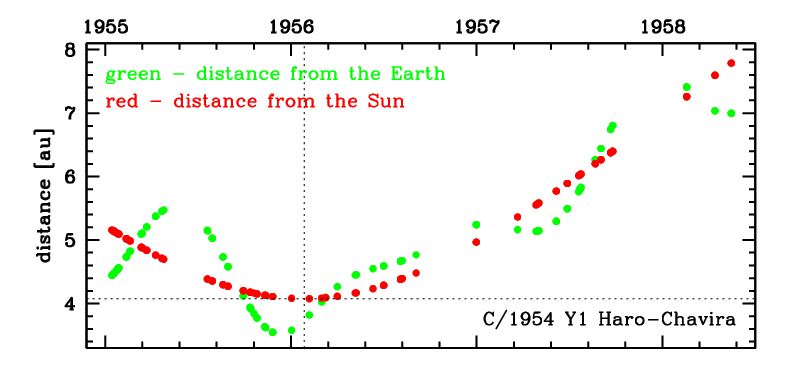C/1954 Y1 Haro-Chavira
more info
Comet C/1954 Y1 was discovered on 18 December 1954, about one year before perihelion passage, and was last seen on 15 May 1958 [Kronk, Cometography: Volume 4].
The comet made its closest approach to the Earth on 9 December 1955 (3.51 au), almost seven weeks before perihelion passage.
Solution given here is based on data spanning over 3.3 yr in a range of heliocentric distances: 5.16 au – 4.08 au (perihelion) – 7.79 au.
This Oort spike comet suffers small planetary perturbations during its passage through the planetary system that lead to escape the comet from the solar system on a hyperbolic orbit (see future barycentric orbit).
See also Królikowska and Dybczyński 2017.
The comet made its closest approach to the Earth on 9 December 1955 (3.51 au), almost seven weeks before perihelion passage.
Solution given here is based on data spanning over 3.3 yr in a range of heliocentric distances: 5.16 au – 4.08 au (perihelion) – 7.79 au.
This Oort spike comet suffers small planetary perturbations during its passage through the planetary system that lead to escape the comet from the solar system on a hyperbolic orbit (see future barycentric orbit).
See also Królikowska and Dybczyński 2017.
| solution description | ||
|---|---|---|
| number of observations | 97 | |
| data interval | 1955 01 13 – 1958 05 15 | |
| data type | perihelion within the observation arc (FULL) | |
| data arc selection | entire data set (STD) | |
| range of heliocentric distances | 5.16 au – 4.08 au (perihelion) – 7.79 au | |
| detectability of NG effects in the comet's motion | NG effects not determinable | |
| type of model of motion | GR - gravitational orbit | |
| data weighting | YES | |
| number of residuals | 181 | |
| RMS [arcseconds] | 0.98 | |
| orbit quality class | 1a | |
| next orbit statistics, both Galactic and stellar perturbations were taken into account | ||
|---|---|---|
| no. of returning VCs in the swarm | 0 | |
| no. of escaping VCs in the swarm | 5001 | |
| no. of hyperbolas among escaping VCs in the swarm | 5001 | * |
| next reciprocal semi-major axis [10-6 au-1] | -231.73 – -228.33 – -224.99 | |
| next perihelion distance [au] | 0.472 – 0.49 – 0.508 | |
| synchronous stop epoch [Myr] | 1.1 | S |
| percentage of VCs with qnext < 10 | 100 | |
| next_g orbit statistics, here only the Galactic tide has been included | ||
|---|---|---|
| no. of returning VCs in the swarm | 0 | |
| no. of escaping VCs in the swarm | 5001 | |
| no. of hyperbolas among escaping VCs in the swarm | 5001 | * |
| next reciprocal semi-major axis [10-6 au-1] | -231.81 – -228.41 – -225.07 | |
| next perihelion distance [au] | 1.07 – 1.08 – 1.09 | |
| synchronous stop epoch [Myr] | 1.12 | S |
| percentage of VCs with qnext < 10 | 100 | |
